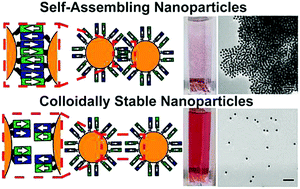Colloidal stability versus self-assembly of nanoparticles controlled by coiled-coil protein interactions†
Abstract
Orientational discrimination of biomolecular recognition is exploited here as a molecular engineering tool to regulate nanoparticle self-assembly or stability. Nanoparticles are conjugated with the heterodimerizing coiled-coils, A and B, which associate in parallel orientation. Simply flipping the orientation of one coiled-coil results in either self-assembling or colloidally stable nanoparticles.



 Please wait while we load your content...
Please wait while we load your content...
